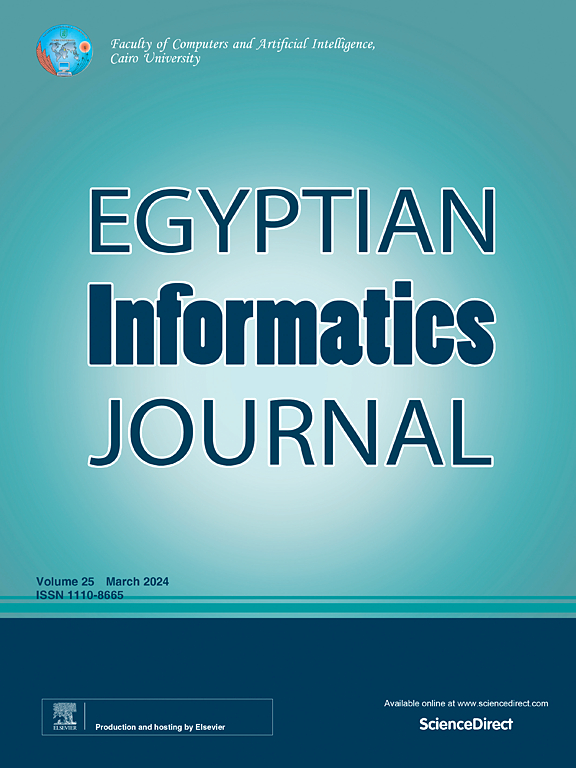通过生成式人工智能和迁移学习增强基于物联网的健康监测的个性化
IF 4.3
3区 计算机科学
Q1 COMPUTER SCIENCE, ARTIFICIAL INTELLIGENCE
引用次数: 0
摘要
由于物联网(IoT)设备的快速扩展,医疗保健部门负责大量的实时数据,这为自定义健康指标提供了动力。在此背景下,目前的研究试图通过提出一个开创性的系统来填补这一空白,该系统在基于物联网的健康监测领域采用生成式人工智能技术和迁移学习。在检查物联网健康数据之前,我们必须通过数据清理消除任何潜在的差异和错误。一种称为延迟误差归一化LMS (DENLMS)的自适应滤波器是一种非常复杂的方法,它本质上有助于提高这些特定数据的精度和准确性。通过对数据进行频域分析,我们能够通过快速傅里叶变换(FFT)提取特征,并随后回顾包含心率变异性或随时间变化的呼吸信号的会话。开发用于个人健康监测的生成式人工智能模型的过程涉及选择合适的模型,例如生成式对抗网络(gan)或变分自动编码器(VAEs),因为它们能够有效地生成和模拟健康数据模式。为了便于功能数据分析,系统设计将机器学习技术与来自各种物联网设备的患者数据生成模型集成在一起。重要的是,该技术的准确率为95.6%,准确率为96.4%,召回率为94.7%,F1得分为95.5%。这些指标超过了本研究中描述的大多数其他技术,证明了该研究技术优于其他通用算法及其使用Python软件实现的性能。未来的研究还可以专注于解决看似微不足道的挑战,即增强模型的适应性和可扩展性,以满足个人健康需求并集成多个数据源。本文章由计算机程序翻译,如有差异,请以英文原文为准。
Enhancing personalization in IoT-based health monitoring via generative AI and transfer learning
Owing to the rapid expansion of Internet of Things (IoT) devices, the health care sector is responsible for immense amounts of real-time data, which provides an impetus for custom health metrics. In this context, the current research seeks to fill this gap by proposing a groundbreaking system that employs generative AI technologies and transfer learning in the field of IoT-based health monitoring. Before examining the IoT health data, we must remove any potential discrepancies and errors through data cleaning. An adaptive filter referred to as the delayed error normalized LMS (DENLMS) is a highly sophisticated method that essentially contributes to increasing the precision and accuracy of these particular data. By applying analysis in the frequency domain to the data, we were able to extract features via the fast Fourier transform (FFT) and subsequently review sessions that contained, for example, heart rate variability or respiratory signals over time. The process of developing a generative AI model for personal health monitoring involves selecting suitable models, such as generative adversarial networks (GANs) or variational autoencoders (VAEs), owing to their ability to generate and simulate health data patterns effectively. To facilitate functional data analysis, the system design integrates machine learning techniques with generative models for patient data from various IoT devices. Importantly, the accuracy rate of this technique is 95.6%, the precision rate is 96.4%, the recall rate is 94.7%, and the F1 score is 95.5%. These metrics surpass those of most other techniques described in this study, demonstrating the superior performance of this research technique over other generic algorithms and its implementation with Python software. Future research could also focus on addressing the seemingly trivial challenge of enhancing model adaptability and scalability to meet individual health requirements and integrate multiple data sources.
求助全文
通过发布文献求助,成功后即可免费获取论文全文。
去求助
来源期刊

Egyptian Informatics Journal
Decision Sciences-Management Science and Operations Research
CiteScore
11.10
自引率
1.90%
发文量
59
审稿时长
110 days
期刊介绍:
The Egyptian Informatics Journal is published by the Faculty of Computers and Artificial Intelligence, Cairo University. This Journal provides a forum for the state-of-the-art research and development in the fields of computing, including computer sciences, information technologies, information systems, operations research and decision support. Innovative and not-previously-published work in subjects covered by the Journal is encouraged to be submitted, whether from academic, research or commercial sources.
 求助内容:
求助内容: 应助结果提醒方式:
应助结果提醒方式:


